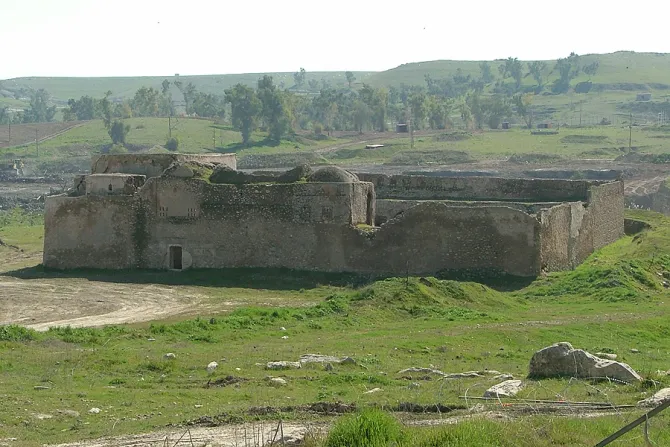Mosul, Iraq, Jan 22, 2016 / 00:02 am
St. Elijah's Monastery in Mosul dated back to the sixth century, making it the oldest Christian monastery in Iraq. Muslims and Christians alike have made pilgrimages to the Chaldean Catholic monastery, invoking both poets and historians to write about its religious impact within the Middle East.
The Associated Press obtained satellite images this month showing that St. Elijah's, also known as Dair Mar Elia, was demolished by militants of the Islamic State, a militant Sunni Islamist organization, between Aug. 27 and Sept. 28, 2014. The AP published the images Jan. 20.
Mosul, Iraq's second-largest city, was overrun by the Islamic State in June 2014. In August, it further extended its reach in the regions surrounding the city. The militants have displaced hundreds of thousands of Christians, Yazidis, and Shia Muslims from their homes while slaughtering or enslaving thousands of others.
"We see it as an attempt to expel us from Iraq, eliminating and finishing our existence in this land," Fr. Paul Thabit Habib, a Catholic priest from Mosul who now lives in Erbil, told The Associated Press. He added that the monastery was "a very important place for the history of the Church in Iraq."
St. Elijah's was located about four miles south of Mosul. It was built in the late sixth century and renovated or rebuilt several times. It was used by monastics until 1743, when a Persian shah martyred the 150 monks who lived there and refused to convert to Islam. The monastery then became a pilgrimage site.
James Foley, a journalist who was to be beheaded by the Islamic State in August 2014, recorded efforts by the United States military to help renovate the monastery in 2008 during the Iraq War.
The Chaldean Patriarch of Babylon, Louis Raphael I Sako, told Vatican Radio Jan. 21 that the destruction of St. Elijah's is disastrous and that the Islamic State are trying to "cancel the memory" of Christianity's ancient heritage in Iraq.
Fr. Federico Lombardi, Holy See press offier, told the AP that "unfortunately, there is this systemic destruction of precious sites, not only cultural, but also religious and spiritual. It's very sad and dramatic."
St. Elijah's Monastery is not the first ancient site to be destroyed by the Islamic State since they declared a caliphate in June 2014. It destroys any non-Sunni religious sites, which it regards as pagan.
By the end of July, the caliphate had seized Mosul's some 30 churches and monasteries, removing their crosses, and looting or burning most of them. The Syriac Orthodox cathedral of Mar Ephraim was turned into a mosque. In November 2014 al-Nasir convent and St. George's parish in Mosul were blown up.
In February 2015 an Iraqi priest told CNA that his former monastery in Mosul is now "a prison for women – most of them are from the Yazidi religion – who were captured and taken as slaves." And in August 2015, the group bulldozed Mar Elian Monastery, a Syrian structure that was founded before the year 500.
Shia mosques and shrines in Mosul have been similarly demolished.
The group have destroyed several pre-Christian sites as well, including at Nimrud, Hatra, Nineveh, and Palmyra. The tomb of the prophet Jonah, on which a mosque had been built, was destroyed with explosives in July 2014.
It is feared that since the Islamic State does not always publicize its destruction, and information does not flow freely from the caliphate, more demolition has occurred than is known.
Archbishop Bashar Warda of the Chaldean Archeparchy of Erbil told CNA in June 2015 that the Islamic State "have destroyed walls and historical sites, but they were unable to destroy the faith of the community. And that's the good news. That our people our people are strong enough to leave everything behind and just stay Christians."


